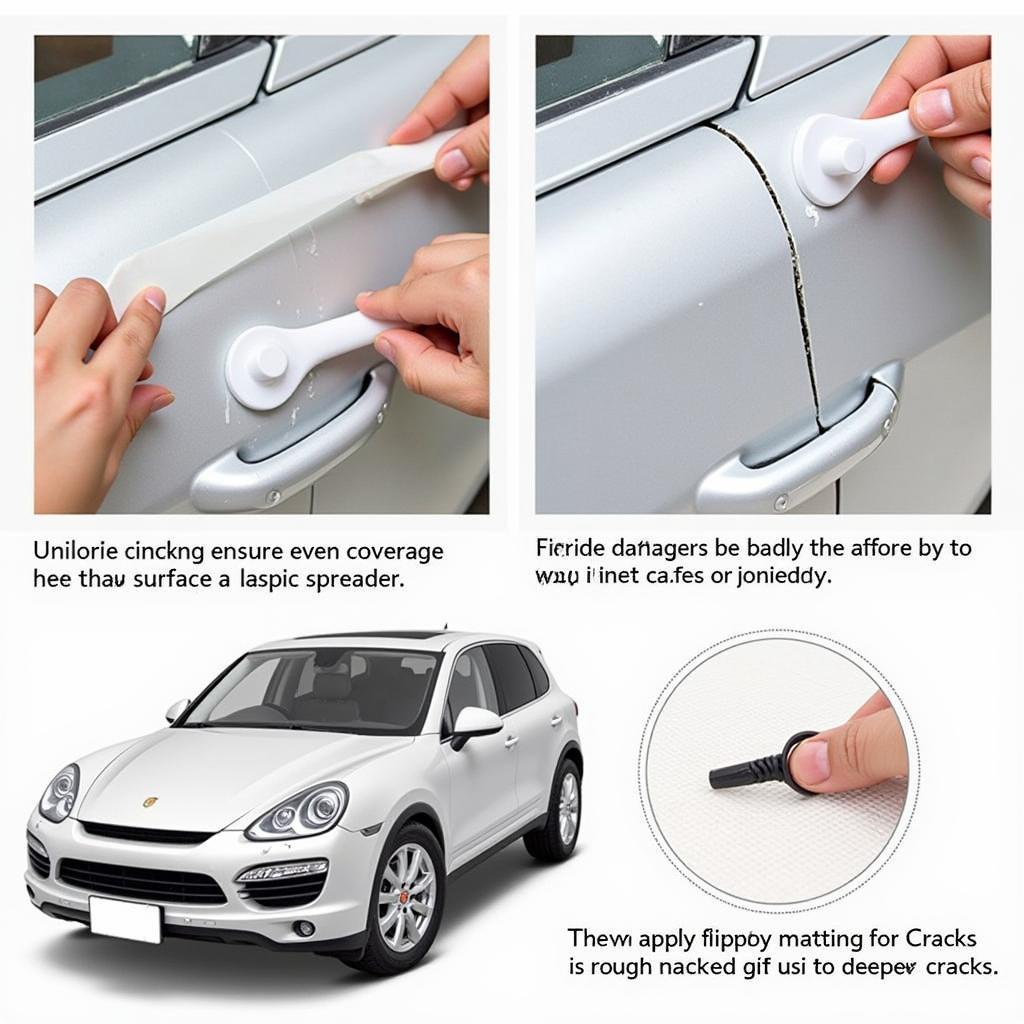Fixing minor fiberglass cracks in car surfaces is a common DIY repair that can save you time and money. This guide will walk you through the process, from identifying the damage to achieving a professional-looking finish. We’ll cover the tools you’ll need, the step-by-step repair procedure, and tips for preventing future cracks.
Identifying and Assessing the Damage
Before you start fixing minor fiberglass cracks in car surfaces, it’s essential to assess the damage. Is it a hairline crack, or is it deeper and more substantial? The repair process will vary slightly depending on the severity of the crack. Clean the area thoroughly with soap and water, then dry it completely. This will allow you to see the crack clearly and ensure proper adhesion of the repair materials. Sometimes, what appears to be a simple crack can be more extensive underneath the surface. Push gently around the crack to check for any give or softness, indicating more significant underlying damage.
 Identifying Minor Fiberglass Cracks
Identifying Minor Fiberglass Cracks
Do you enjoy tinkering with cars, even in the virtual world? Check out these resources: how to fix car roblox.
Gathering Your Tools and Materials
Having the right tools and materials is crucial for a successful repair. You’ll need: fiberglass resin, hardener, fiberglass mat or cloth (depending on the crack’s depth), mixing sticks, sandpaper (various grits), masking tape, a plastic spreader, safety glasses, gloves, and a respirator.
Choosing the Right Resin and Hardener
Selecting the appropriate resin and hardener is vital for a durable and long-lasting repair. Choose a high-quality automotive-grade resin. The hardener is what catalyzes the resin, causing it to harden. Follow the manufacturer’s instructions carefully for the correct mixing ratio.
Step-by-Step Repair Guide
-
Preparation: Mask off the area around the crack with masking tape to protect the surrounding paint. Lightly sand the cracked area with coarse sandpaper to create a rough surface for the resin to adhere to.
-
Mixing the Resin: In a well-ventilated area, carefully measure and mix the resin and hardener according to the manufacturer’s instructions. Mix thoroughly but avoid introducing air bubbles.
-
Applying the Resin: Using the plastic spreader, apply a thin layer of resin to the cracked area, ensuring it penetrates the crack. If the crack is deeper, apply a piece of fiberglass mat or cloth over the resin and saturate it with more resin.
 Applying Fiberglass Resin to Car Crack
Applying Fiberglass Resin to Car Crack
For those who enjoy the challenge of virtual car repairs, you might be interested in fixing car games play online.
-
Curing: Allow the resin to cure completely according to the manufacturer’s instructions. This usually takes several hours.
-
Sanding and Finishing: Once cured, sand the repaired area with progressively finer grits of sandpaper until smooth. Prime and paint the area to match the surrounding car surface.
Preventing Future Fiberglass Cracks
Regularly waxing and polishing your car can help protect the fiberglass from UV damage and prevent cracking. Avoid exposing your car to extreme temperatures and impacts. Inspect your car’s fiberglass surfaces regularly for any signs of cracking and address them promptly to prevent them from worsening.
Experiencing bouncy car issues in Jailbreak? Find potential solutions at [how to fix bouncy cars in jailbreak xbox](https://autotippro.com/how to fix bouncy cars in jailbreak xbox/). Alternatively, if you’re having similar issues in the 2021 version, check out how to fix bouncy cars in jailbreak 2021.
“Regular maintenance and prompt repairs are key to preserving the integrity of your car’s fiberglass surfaces,” says automotive expert, Dr. Emily Carter.
“Addressing minor cracks early can prevent them from developing into more significant and costly repairs,” adds John Miller, a seasoned auto body technician.
Conclusion
Fixing minor fiberglass cracks in car surfaces is a manageable DIY project with the right knowledge and tools. By following these steps, you can restore your car’s appearance and prevent further damage. Remember to always prioritize safety by wearing appropriate protective gear. If you’re unsure about any step, consult a professional. Connect with us at AutoTipPro for further assistance. Our phone number is +1 (641) 206-8880 and our office is located at 500 N St Mary’s St, San Antonio, TX 78205, United States. We’re always here to help!




Leave a Reply